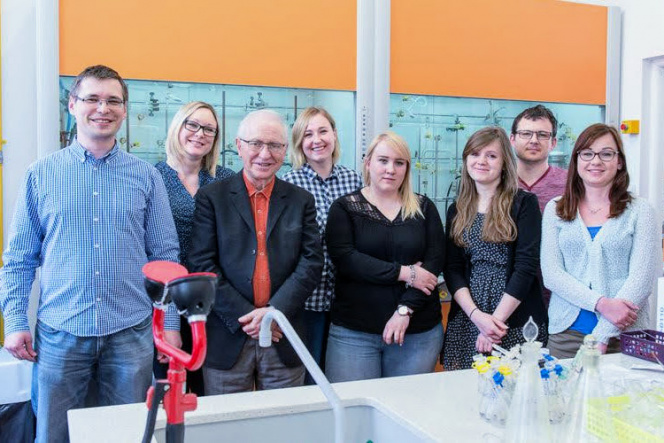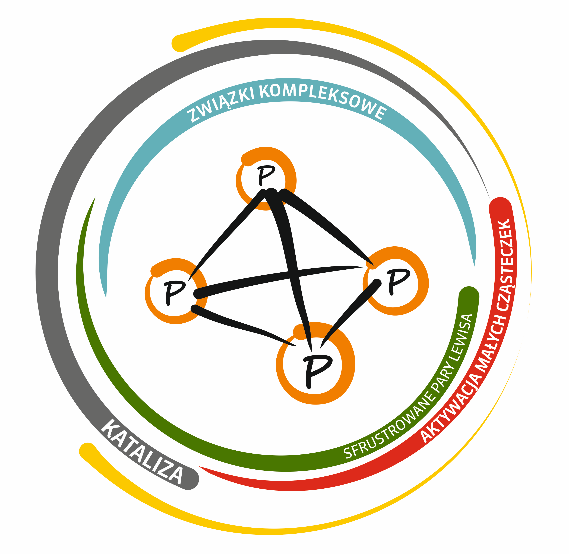
Members
- Dr. Rafał Grubba, Ph.D., D.Sc., Eng.
- Prof. Jerzy Pikies, Ph.D., D.Sc., Eng.
- Dr. Łukasz Ponikiewski, Ph.D., Eng.
- Dr. Kinga Kaniewska-Laskowska, Ph.D., Eng.
- Dr. Aleksandra Ziółkowska, Ph.D., Eng.
- Dr. Anna Ordyszewska, Ph.D., Eng.
- Natalia Szynkiewicz, M.Sc., Eng.

Scope
Our research interests include the chemistry of transition metal complexes with P-donor ligands and the chemistry of elements of main groups, with particular emphasis on phosphorus and boron chemistry. The main goal of our research is to develop new inorganic synthesis methods and the aim of the projects is to discover new types of reactivity and catalysts useful in important chemical processes.
Current projects focus mainly on the following issues:
- Low-valent phosphorus compounds: the project provides fundamental information about low-valent phosphorus compounds that exhibit high reactivity. Like carbene complexes of transition metals, their phosphinidene and phosphido counterparts can have applications in organic synthesis and chemical catalysis.
- Synthesis and research on the reactivity of polyphosphorus compounds: the project aims to develop new, polydentate P-donor ligands and coordination polymers with application with synthesis of new materials and catalysis.
- Reactivity of Lewis frustrated hydrogen pairs (FLP): these studies develop new, non-metallic hydrogenation catalysts.
- Activation of small inorganic molecules (CO2, CS2, SO2, N2O, catalyzed by phosphorus and boron compounds): these studies open the way to completely new reactions using simple substrates.
At the disposal of the members of the research group there are the following apparatus:
- X-ray diffractometer
- NMR spectrometer
- glove box
- 6 work stations in an inert gas atmosphere equipped with vacuum lines
Cooperation offer
We invite students of all levels and specialties as well as other research groups. For students, we offer interesting topics for diploma theses, the opportunity to participate in research projects and work in a young, dynamically developing team.
Selected publications
- N. Szynkiewicz, A. Ordyszewska, J. Chojnacki, R. Grubba: Diphosphinoboranes as Intramolecular Frustrated Lewis Pairs: P−B−P Bond Systems for the Activation of Dihydrogen, Carbon Dioxide, and Phenyl Isocyanate. Inorg. Chem. 60 (2021) 3794-3806, doi:10.1021/acs.inorgchem.0c03563.
- K. Kaniewska, Ł. Ponikiewski, N. Szynkiewicz, B. M. Cieślik, J. P. Pikies, J. Krzystek, A. Dragulescu-Andrasi, S. A. Stoian and R.Grubba, Homoleptic mono-, di-, and tetra-iron complexes featuring phosphido ligands: a synthetic, structural, and spectroscopic study. Dalton Trans. 49 (2020) 10091-10103, doi:10.1039/D0DT01503B.
- A. Ordyszewska, N. Szynkiewicz, J. Chojnacki, J. Pikies, R. Grubba: The Reactivity of Phosphanylphosphinidene Complexes of Transition Metals Toward Terminal Dihaloalkanes. Inorg. Chem. 59 (2020) 5463-5474, doi:10.1021/acs.inorgchem.0c00091.
- A. Ziółkowska, N. Szynkiewicz, J. Pikies, Ł. Ponikiewski: Synthesis of compounds with C-P-P and C=P-P bond systems based on the phospha-Wittig reaction. Dalton Trans. 49 (2020) 13635-13646, doi:10.1039/D0DT02728F.
- A. Ziółkowska, N. Szynkiewicz, J. Pikies, Ł. Ponikiewski: Solvent Impact on the Diversity of Products in the Reaction of Lithium Diphenylphosphide and a Ti(III) Complex Supported by a tBu2P–P(SiMe3) Ligand. Inorg. Chem. 59 (2020) 11305-11315, doi:10.1021/acs.inorgchem.0c00824.
- N. Szynkiewicz, Ł. Ponikiewski, R. Grubba: Diphosphination of CO2 and CS2 mediated by frustrated Lewis pairs - catalytic route to phosphanyl derivatives of formic and dithioformic acid. Chem. Commun. 55 (2019) 2928-2931, doi:10.1039/C9CC00621D.




